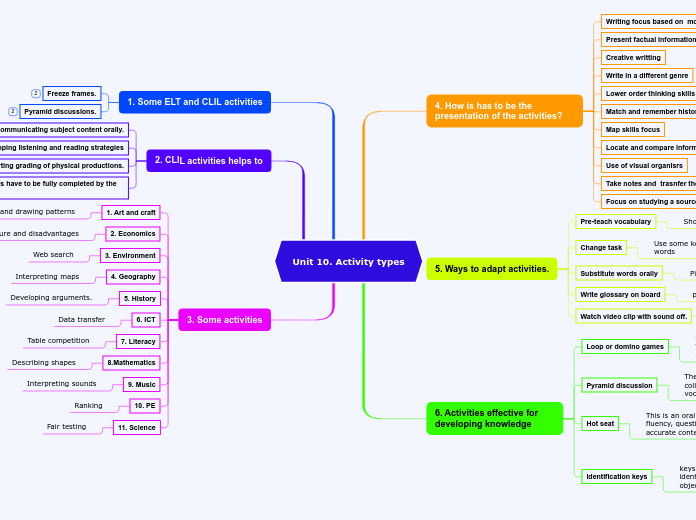Unit 10. Activity types
4. How is has to be the presentation of the activities?
Writing focus based on model text.
Present factual information about local context
Creative writting
Write in a different genre
Lower order thinking skills focus
Match and remember historical facts
Map skills focus
Locate and compare information
Use of visual organisrs
Take notes and trasnfer the info
Focus on studying a source*
5. Ways to adapt activities.
Pre-teach vocabulary
Show how good you are by telling your friends
Change task
Use some key
words
Substitute words orally
Pictures
Write glossary on board
places they knew
Watch video clip with sound off.
ask learners what they saw.
6. Activities effective for developing knowledge
Loop or domino games
these can be used to revisit content vocabulary. They develop accuracy and intensive listening skills.
Pyramid discussion
The activity develops oral communication, collaboration and production of content vocabulary
Hot seat
This is an oral activity to develop communicative fluency, questioning skills and reporting of accurate content facts.
Identification keys
keys can be used as activities to identify, categorise and compare objects, people, places
Binary
they involve a progression of questions which have only two possible answers
Lateral
they are used for comparing features
1. Some ELT and CLIL activities
Freeze frames.
Pyramid discussions.
2. CLIL activities helps to
Communicating subject content orally.
Developing listening and reading strategies
Supporting grading of physical productions.
All this activities have to be fully completed by the time.
3. Some activities
1. Art and craft
Observing and drawing patterns
2. Economics
Starting adventure and disadvantages
3. Environment
Web search
4. Geography
Interpreting maps
5. History
Developing arguments.
6. ICT
Data transfer
7. Literacy
Table competition
8.Mathematics
Describing shapes
9. Music
Interpreting sounds
10. PE
Ranking
11. Science
Fair testing
